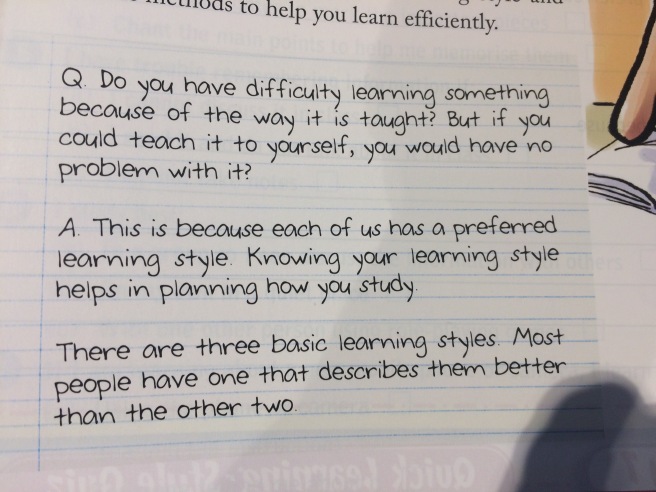
“Welcome to the science lab, boys and girls. Today’s Learning Outcome is on the board: by the end of the lesson you will all be able to appreciate the shape of the Earth and analyse various theories as to how this shape was formed. I’m going to be the sage on the stage for thirty seconds and then we’ll do some discovery learning whereby you’ll walk around the school, in groups, and report back what gradient measures you have taken, as well as your qualitative analysis, and what these might tell us about the shape of the Earth.
As you all know, the Earth is a big, flat circle, with scary sea-monsters near the edge bits. The sun travels around the Earth, giving us night and day…..”
Sounds far-fetched, doesn’t it? You’d be worried if your child came home from school relating that the science teacher told them that the moon was made of cheese, or that evolution was a dubious theory. What if their SPHE teacher gave them a questionnaire to help them determine their dominant humour, and asked them to form groups with other members of their “humour” style and discuss how this was affecting their health and learning? It’s unlikely your response would be: “You got Sanguine? That is so cool. Did you know that I’m a Sanguine too? Not like your Dad, though. He’s more Phlegmatic. Totally different….”
You wouldn’t think it was cool, because you recognise an out-dated theory when you see one. How would you feel about this test, and this activity?
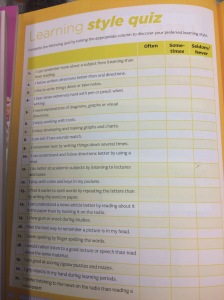
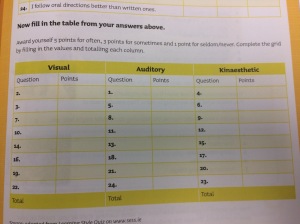
These pages are from a brand-new textbook, intended to be used when teaching SPHE as part of the new Wellbeing programme. Here a similar example from another new textbook
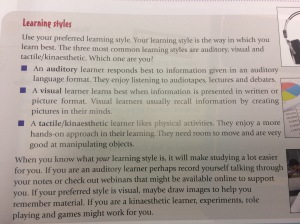
And more, from a third publishing company

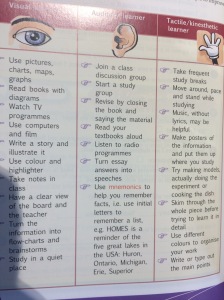
The problem with these images is that the information they contain is completely false. The theory of “learning styles” has been described by Professor Paul Kirschner as nothing more than an “urban legend”, and in this letter to the Guardian leading scientists have argued for its complete removal from schooling. It could be that offerings from the other educational companies feature similar content, so I won’t say here who publishes these books. Neither do I want to imply that the publishers did not carry out due diligence in ensuring that the content of their textbooks reflects the curriculum; it would be unfair to blame the publishers when the source of their information is the Department of Education itself.
The source of the Learning Style quiz is the Departmental website http://www.sess.ie. It is found in materials that were presented to school leaders at a conference in 2009. Now, in educational terms, 2009 is a long time ago and many of the people believed in learning styles at that time no longer do. Nevertheless these materials are still present on their website and have been used, entirely reasonably, as resources by the authors of the textbooks.
Here is the Learning Styles questionnaire that forms the basis of that found in three of the textbooks I looked at. Here is advice for teachers on how to help children with special educational needs. “Establish the student’s preferred learning style” is number 3 on the list. These are from the SESS website: there is a link to the questionnaire on the Junior Cycle website that is dated April 2015. The PDST also feature learning styles in some of their material, such as here and here, even though they do caution about their use here. The section of the PDST responsible for technology recommends increased use of ICT in classrooms because it “can offer an opportunity to accommodate differing learning styles” . The department-sponsored Scoilnet website offers a learning-styles quiz resource that was uploaded in April 2017, and the Departmental website itself promotes the LCA programme as being suitable “for those whose needs, aptitudes and learning styles are not fully catered for by the other two Leaving Certificate programmes.” (The LCA is a useful and scandalously under-resourced programme, but the link with learning styles is entirely spurious.)
The most recent reference to learning styles in the Junior Cycle Irish Specification, a document published only months ago and which first years of 2017-2018 will be the first cohort to undergo. As pupils progress through the specification: “They gradually become familiar with their own learning strategies and personal style of learning.”
This is Irish education policy in 2017. One of the most discredited fads of the twentieth century is a central tenet of reforms on which we are only just embarking. Even leaving out the subjection of children to the ludicrous VAK sorting-hat, the notion of personal learning styles – of each child learning in a particular way – and of the benefits of personalised instruction and personalised study strategies runs right through the Junior Cycle Framework. For example, the theory has been used to justify portfolio-based assessment “Portfolios provide benefits for students with different preferred learning styles and capacity for oral feedback from teachers.” [italics mine] One of the guidance-related learning outcomes from the Wellbeing specification states that children must be able to “recognise their own ways of learning and their learning habits, interests, strengths and weaknesses”. [italics mine] Elsewhere is this document teachers are exhorted to “[take] account of the diverse needs and learning approaches of students.” [italics mine] and reminded that schools should “[recognise] students as experts in their own learning”.
The photo below on the left shows where thinking of children as “experts in their own learning” might lead us. The one on the right shows us what can happen when a curriculum specifies that children will reflect on their learning, not what it is that they are actually required to learn.
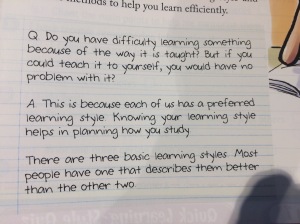
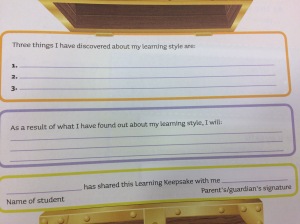
The photos above are not relics. They are from new books, published in 2017, and intended for the new programmes that are being rolled out and will be taught to children just leaving primary school and those coming up through primary school. Teacher and psychologist Nick Rose describes learning styles “lack validity” and “provide no pedagogic value whatsoever”. They contradict what cognitive science tells us:
“Children are more alike than different in terms of how they think and learn”
Daniel Willingham, Professor of Psychology at University of Virginia
This neuromyth not just harmless nonsense.It promotes ineffective study methods that introduce and/or widen attainment gaps. One textbook advises “kinaesthetic learners” to “take frequent breaks from study”. Breaks from study are a good idea, but you don’t learn anything during them, and the child who schedules extra breaks because she thinks they’re some kind of strategy is likely to learn less than the child who takes a break at average intervals. It also promotes the false idea that learning should be easy, enjoyable and at the very least feel “natural”. Prematurely asking children to categorise themselves is always a dangerous and counterproductive classroom activity and ironically promotes the antithesis of the “growth mindset” also mentioned in the Wellbeing specification. Most worryingly of all, attempts to assess children’s learning styles seem most prevalent in special needs education within mainstream settings, where they both provide a plausible but false explanation for low attainment, and also promote the adoption of strategies unlikely to lead to real progress.
That a pseudoscientific and completely debunked theory can be printed in textbooks and taught to children as factual knowledge should worry everyone, including parents. It really is like a science diagram showing a flat Earth and the sun’s orbit around us. It could even be argued to be worse as this false information in one area – SPHE – has the potential to corrupt learning in every single subject from Spanish to Science to Geography. As to how this came to happen, a good place to start might be the Department of Education’s own lack of understanding of – and at times disdain for – knowledge. We have a curriculum that does not include syllabi that specify the content that children must master. Instead we have broad frameworks that imply content matters less than whether teachers are employing approved progressive methods and children are developing “transferable skills”.
This is what happens when you downgrade knowledge and fail to specify the facts and subject content which with children should be familiar at each stage of their education. A vacuum is created, into which can rush all kinds of nonsense. When there is little culture of using evidence to inform practice, this nonsense is easily found in the materials provided by the department itself. When the time allocated for teaching academic subjects – wherein there is a vast storehouse of accumulated knowledge built up through centuries – is cut in favour of nascent “areas of learning”, this makes the vacuum bigger. And when this area of learning is designed to be delivered not by subject experts with degrees in the course content, but by teachers who hold any qualification at all, then you decrease the likelihood that teachers will themselves spot the fake facts and misinformation.
Purging the textbooks of false information is easy. Educating teachers about the pitfalls of neuromyths is more onerous, yet is doable: look for example at the stellar work of Tom Bennett and the ResearchEd movement. The hard part is contemplating the looming disaster of a secondary system that may speak about “high expectations” for all, but by eschewing rigour, evidence and knowledge in favour of engagement, skills and the “learner experience”, risks creating schools that resemble day-care for teenagers. It won’t seem to matter if children spend less time in real lessons than they do floating along in a tide of pseudolearning and obsession with their own subjective viewpoints. Our young people may well leave such schools knowing barely more about the wider world than they did when they entered. And it will be a tragic waste.
For more information on how learning styles don’t exist, these are a good place to start:
Daniel Willingham’s FAQ on Learning Styles
For information about effective study skills that are based on reputable research and work for everyone, check out The Learning Scientists at www.learningscientists.org
Excellent appraisal of a hugely problematic ‘reform’. I have visions of pupils raising their hands in class, informing me that they are visual/auditory/tactile learners, that I am unfortunately not catering for their learning style, and if I could please revise my teaching methods ASAP.
LikeLike
I have found that a pre-emptive strike works well. I drop a hint that this crazy idea exist, and it’s unlikely they’ll ever come across it, but that it’s good to be prepared. It makes a nice choral response “What do we say if anyone asks us to assess our learning style?1-2-3…” “Learning styles don’t exist!!”.
However, that’s easier when it wasn’t there in black, white and other colours in an actual textbook. Kids tend to view the textbook as the last word of some higher, mysterious authority, and it’s one thing to correct your own book in your own class but telling them a book used by another teacher in another subject is wrong is much trickier. Contradicts an important principle of all adults in the school presenting a united front, and could lead to some awkward conversations….
I think that question in the first photo “Are you a better teacher than your teacher…?” has to be the worst thing I’ve ever read in a textbook, outside and regardless of any theories or any evidence.
LikeLiked by 1 person
So – what next?
As someone who has been challenging government guidance promoting mixed methods, multi-cueing word-guessing reading strategies, since the National Literacy Strategy was rolled out in 1998 – progressing to challenging government in its simultaneous promotion in 2006 of the discredited multi-cueing word-guessing strategies of Reading Recovery (under the ‘Every Child a Reader’ umbrella) whilst rejecting the multi-cueing word-guessing strategies of the ‘Searchlights’ model in its acceptance of the Simple View of Reading model, the issue is surely not about multi-cueing reading strategies, or various learning styles – it is about how to quickly and efficiently hold official departments and people with authority – to account.
If only all the brilliant bloggers that abound nowadays would turn their attention on to that topic.
I have read fantastic post after fantastic post about all the current issues regarding becoming a research-informed teaching profession – but no-one is tackling the issue of holding people in authority to account.
I have tried myself to hold Ofsted – and other official organisations – to account when blatant injustice was the topic (illegal exclusions) – and was faced with only obfuscation, stonewalling, and so on, with no sense of these organisations being accountable through simple, accessible mechanisms.
I suggest, then, that the topic all you brilliant bloggers might now discuss is, ‘How to hold those in authority to account for promoting wrong ideas and injustices’.
LikeLiked by 1 person
Reblogged this on The Echo Chamber.
LikeLike
How astounding to see the learning styles stuff in a 2017 textbook. Will you be writing to the publishers of the book with a summary of the evidence and a request they revise the book immediately? I did so once to do with some significant errors in a science textbook and they revised it immediately, perhaps you will be so lucky.
LikeLike